Chemical Safety
From detergents and paint to pesticides and bleaches, in this day and age, chemicals are a part of everyday daily life. This is all very well, but do you have the information you need to make sure you are avoiding any potential risks and keeping yourself and others safe?
Chemical Symbols and Pictograms
The best way to keep safe is to be vigilant of any hazard symbols or pictograms. These have recently been updated to be clearer on packaging and more universally understandable, as well as abiding by the change in law for chemical classification and labelling.
Old:
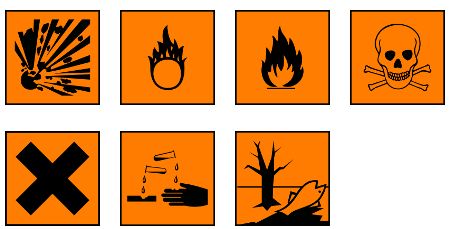
New:
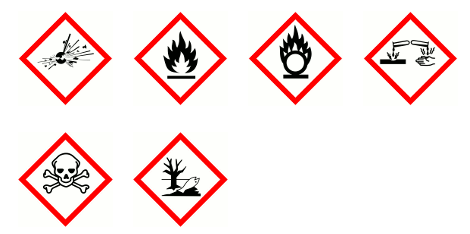
The harmful symbol pictogram has also changed:
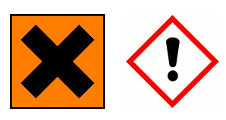
As well as a couple of new pictograms to add to the list.
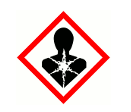
It reflects the serious longer term health hazards such as carcinogenicity (cancer causing) and respiratory sensitisation.
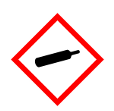
This pictogram means that it ‘Contains gas under pressure’
When dealing with chemicals, it is worth compiling what is known as an SDS (Safety Data Sheets) these sheets contain all the information that people will need to know when handling the chemicals.
There is a full safety data sheet document available online which goes into detail of what should be included..
The manufacturing, use, transportation and disposal of chemicals
Even though the chemical industry provides us with goods we take for granted, there are certain risks that come with manufacturing, using, transporting or disposing of chemicals.
Manufacturing chemicals
As well as understanding and managing the risks associated with the chemicals you are manufacturing or importing, as a manufacturer or supplier of chemicals you will need to comply with the Chemicals (Hazard Information and Packaging for Supply) CHIP Regulations. You can find out more information about it from the REACH website.
The CHIP regulations are gradually being replaced however with CLP Regulation (as detailed above) this is to create a Globally Harmonised System (GHS) across the UK and Europe for classification and labelling.
If you are exporting chemicals outside the EU then the HSE has to be notified in some cases, and they may require the Prior Informed Consent (PIC) of the importing country.
Also, where hazardous substance or chemicals are stored in large quantities, you will need to meet requirements which reduce the possibility of accidents and cause damage or injuries to anyone within the vicinity. You can find out in depth information about this on the COMAH website.
Using Chemicals
As an employer, it is your responsibility to make sure that the use of chemicals or other hazardous substance is done in a safe and considerable manner. You should also ensure that care is taken with any chemicals which could cause diseases including asthma, dermatitis, or cancer. If this affects your company, you should visit the Control of Substances Hazardous to Heath Regulations (COSHH) website for further details.
You should also have Safety Data Sheets (SDS – mentioned earlier on in the article) these are designed to help you and employees make risk assessments and explain which hazards could be present with the chemicals being used, as well as information on handling and storing any emergency measures that need to be taken in case of an accident.
There are also other substances and chemicals you need to be careful of when using, such as;
- Lead
- Biocides and Pesticides
There may also be a risk of fire and explosions, if you work with chemicals which can combust it's best to find out about the dangerous substances and regulations regarding it on the HSE.gov.uk site.
Transporting Chemicals
Whether you are transporting hazardous or dangerous good by rail or road they both involve the potential risk of traffic accidents, this includes spillage of goods which can lead to fires, explosions or chemical burn and even environmental damage.
Luckily, most goods are not considered dangerous enough to warrant extra precautions, but some do possess properties which can make them potentially dangerous if carried.
Disposing Chemicals
Chemical waste needs to be treated, disposed or recycled in a responsible fashion which is not detrimental to human or environmental health.
There are three categories of chemical waste:
- Always Hazardous – i.e lead acid batteries or fluorescent tubes
- Never Hazardous – i.e edible oil
- May or May Not Be Hazardous – i.e ink or paint.
Some substance may also be fire hazards such as petrol or paint, so this needs to be in the forefront of your mind when disposing or recycling.
Making sure that you and your business understand the properties of hazardous waste and the correct way of handling and disposing of it is paramount. There is information available to advise you on the precautions and tests available which determine the compatibility of substances for chemical waste treatment.
You can find out more about the regulations for this from the Environment Agency website as well as REACH who give guidance on waste and recovered substances..
You can also read HSE waste and recycling website for general guidance.
Chemical Spills
Another issue your business may have to deal with is chemical spills, this can occur in warehouses, factories and storerooms when moving stock/goods about.
In the event that you do have a chemical spill it is important to make sure you have an emergency spill kit on site.
These spill kits are designed to soak up chemical spillages that normal cloths/paper towels just can’t withstand.
This is a rough guide to chemical safety, you can find full information through the links provided throughout the article, and if you are in any doubt please contact either HSE or the Environmental Agency for advice.

Author Bio - Laura Holland
Social Media and Web Content Coordinator, Jan 2014 - May 2015




